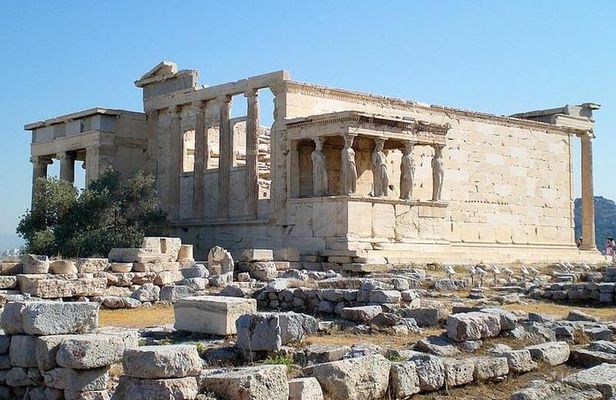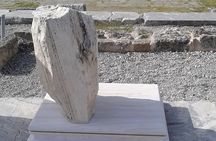
No expiration date
Easy refund
Free exchange
Easy booking
Athens Half day Christian Tour | Apostle Paul first Spoke - Acropolis, Parthenon
$275.01
This is an experience gift voucher. The recipient will book the experience after
they redeem the gift voucher.
Overview
Regarding the spot from where Apostle Paul spoke to the Athenians, it is also said that he preached in front of the High Court’s Body as one of its members (Dionysius the Aeropagite) adopted the ideas of his preaching.
Areopagus was the name of the hill west of the Athenian Acropolis.
In this half-day tour we will drive you to were St.Paul first came to Athens. Then we will visit the Acropolis, the Parthenon,the Erechtheion, Mars Hill (Areopagus), (Acts 17:22) were Apostle Paul delivered his sermon to the Athenians. You then proceed by visiting the Parthenon, the Erechtheion, the Temple of Nike, the tomb of the Unknown Soldier, Parliament House, Presidential Palace, Panathenian Stadium, Temple of Olympian Zeus, the Plaka, the Ancient agora,(St. Paul’s meeting place), the Roman agora, Academy, the University and the National Library.
Areopagus was the name of the hill west of the Athenian Acropolis.
In this half-day tour we will drive you to were St.Paul first came to Athens. Then we will visit the Acropolis, the Parthenon,the Erechtheion, Mars Hill (Areopagus), (Acts 17:22) were Apostle Paul delivered his sermon to the Athenians. You then proceed by visiting the Parthenon, the Erechtheion, the Temple of Nike, the tomb of the Unknown Soldier, Parliament House, Presidential Palace, Panathenian Stadium, Temple of Olympian Zeus, the Plaka, the Ancient agora,(St. Paul’s meeting place), the Roman agora, Academy, the University and the National Library.
—
The experience offers several options. This price includes:
Luxury Sedan
1-4 passengers
Pickup included
1-4 passengers
Pickup included
Tour guide
Language: English
Human tour guide
Duration: 5 hours
The experience offers several options, check yours above
- Air-conditioned vehicle
- WiFi on board
- Bottled water
- Professional drivers with deep knowledge of history (not licensed to accompany you in any site)
- Private transportation
- Ancient Agora (can be purchased on-site)
- Acropolis (must be purchased in advance - limited availability)
- Licensed tour guide (upon request and depending on availability)
- Meals & Drinks
-
PropylaeaAlthough not directly associated with Saint Paul in historical records, this magnificent gateway provides us with a glimpse into the rich tapestry of ancient Athens, a city that the apostle Paul once walked. The Propylaea served as the ceremonial entrance to the Acropolis, the religious and cultural heart of the city. It was a place of great significance, where Athenians and visitors alike would have passed through on their way to worship the gods, participate in civic ceremonies, or admire the architectural marvels atop the sacred hill. As we walk through the central passageway of the Propylaea, let us imagine Saint Paul traversing these same steps, perhaps pondering the philosophical debates and religious practices that surrounded him. Although the apostle's visit to Athens is primarily remembered for his speech at the Areopagus, it's likely that he passed through the Propylaea as he explored the city and engaged with its inhabitants.
-
AcropolisThe Acropolis, with its majestic temples, statues, and monuments, stands as a testament to the architectural and artistic achievements of ancient Greece. It was here, amidst the splendor of classical civilization, that Saint Paul arrived during his missionary journey to spread the teachings of Christianity. Imagine Saint Paul ascending the winding path to the Acropolis, gazing upon the magnificent structures dedicated to the Greek gods and goddesses. The Parthenon, with its graceful columns and intricate sculptures, would have dominated the skyline, a symbol of Athens' devotion to Athena, the city's patron deity. Stand in the shadow of the Parthenon, reflecting on the profound impact of Saint Paul's message in this ancient city. His famous speech at the Areopagus, where he proclaimed the "unknown god" worshipped by the Athenians as the one true God, challenged the prevailing beliefs of the time and laid the foundation for the spread of Christianity in the Greco-Roman world.
-
ParthenonConstructed in the 5th century BCE, the Parthenon was dedicated to Athena, the patron goddess of Athens, and served as the city's monumental centerpiece. Its majestic columns, intricate sculptures, and architectural precision embody the ideals of beauty, harmony, and order revered by the ancient Greeks. Although Saint Paul's visit to Athens is not directly associated with the Parthenon in historical records, his presence in the city during the 1st century CE undoubtedly intersected with the cultural and religious significance of this sacred site. As he walked the streets of Athens and engaged with its inhabitants, Saint Paul would have been confronted by the grandeur of the Parthenon and the beliefs it represented.
-
ErectheionImagine Saint Paul walking among the ancient ruins of the Erechtheion, contemplating the myths and legends that shaped the worldview of the Athenians. As he engaged with the city's inhabitants, including philosophers, poets, and priests, Saint Paul would have encountered a rich tapestry of beliefs and traditions that provided fertile ground for the spread of Christianity. While the Erechtheion stands as a testament to the enduring legacy of ancient Greek civilization, it also serves as a reminder of the transformative power of Saint Paul's message of salvation and redemption. His proclamation of the Gospel challenged the prevailing religious norms of the time and laid the foundation for the Christian faith to take root and flourish in the Greco-Roman world.
-
AreopagoAlso known as Mars Hill, is a historic site atop the Acropolis of Athens steeped in both mythological and biblical significance. The Areopagus served as a revered meeting place in ancient Athens, where the city's council convened to discuss matters of law, philosophy, and religion. Named after Ares, the Greek god of war, and later associated with the Roman god Mars, this sacred site was believed to be the location where Ares was tried for the murder of Poseidon's son. It was here, amidst the grandeur of the Acropolis, that Saint Paul delivered one of his most famous speeches, challenging the beliefs of the Athenians and proclaiming the message of Christianity. In his speech at the Areopagus, Saint Paul acknowledged the religious fervor of the Athenians, noting their altar to the "unknown god." He seized upon this cultural curiosity to introduce them to the God he worshipped, the creator of the universe who transcends human understanding and dwells not in temples made by hands.
-
Ancient Agora of AthensThe Ancient Agora was the beating heart of Athenian life, a vibrant hub where commerce, politics, and social interaction converged. Here, merchants peddled their wares, philosophers engaged in intellectual discourse, and citizens gathered to participate in democratic governance. It was also a place where religious rituals and ceremonies took place, reflecting the diverse spiritual beliefs of the Athenian populace. During his time in Athens, Saint Paul would have undoubtedly traversed the bustling streets of the Agora, engaging with its inhabitants and sharing the message of Christianity. While the Agora is not specifically mentioned in the biblical account of Saint Paul's visit to Athens, its cultural and historical significance cannot be understated. As a center of intellectual inquiry and religious expression, it provided fertile ground for the spread of new ideas and beliefs, including the teachings of Christianity.
-
Stoa of AttalosAn impressive ancient building located within the Ancient Agora of Athens. Although not directly associated with Saint Paul in historical records, the Stoa of Attalos provides valuable insights into the cultural and historical context of his visit to Athens and the spread of Christianity in the ancient world. The Stoa of Attalos was originally built in the 2nd century BCE by King Attalos II of Pergamon as a gift to the city of Athens. It served as a covered walkway or portico, providing shelter for merchants, philosophers, and scholars engaged in commerce, conversation, and intellectual pursuits. Reconstructed in the 1950s, the Stoa of Attalos stands as a striking example of ancient Greek architecture and craftsmanship.
If it’s canceled due to poor weather, you’ll be offered a different date or a full refund.
How it works?
01
—
You choose from 10,000+ experience gifts
02
—
We deliver the eVoucher or the Physical box to the recipient
03
—
Recipient books the experience and creates unforgettable memories!
Athens Half day Christian Tour | Apostle Paul first Spoke - Acropolis, Parthenon
$275.01
This is an experience gift voucher. The recipient will book the experience after
they redeem the gift voucher.
How it works?
01
—
You choose from 10,000+ experience gifts
02
—
We deliver the eVoucher or the Physical box to the recipient
03
—
Recipient books the experience and creates unforgettable memories!




